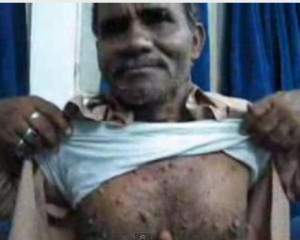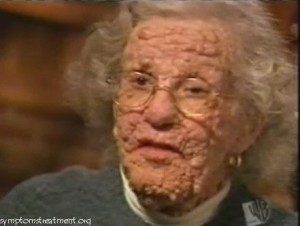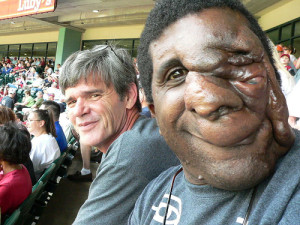Neurofibromatosis is a genetic condition that disturbs the growth of cells in the nervous system, resulting in the formation of tumors on nerve tissue. The tumor can develop at any region of the nervous system including the spinal cord, the brain and the small and large nerves. Neurofibromatosis I generally diagnosed during childhood or the beginning of adulthood.
The tumors not malignant, but benign and the disorder is generally not serious. However, the effects of neurofibromatosis can be many and disruptive. Some of the serious effects of the disorder include loss of hearing, learning and cognitive impairment, cardiovascular disturbances and in some cases even cancer.
The treatment of neurofibromatosis is focused on maximization of development and health growth and to promptly deal with complications that may arise. When there is occurrence of large tumors or tumors that press on a nerve, due to neurofibromatosis, then surgery may be required.
Symptoms of neurofibromatosis
There are three different types of neurofibromatosis and each type has its own distinct signs and symptoms. They are as follows:
Neurofibromatosis 1 (NF1)
It generally occurs during childhood and may show the following symptoms:
- Cafe au lait spots: These are light brown, flat spots on the skin and are harmless. Such spots are common in many individuals, but the presence of more than six spots is a stronger indicator of NF1. Such spots may be present at birth or appear during the first year. Their numbers stabilize after an initial increase during early childhood.
- Soft lumps on or below the skin or neurofibromas: These bumps are benign tumors that occur on the nerve tissue near the skin. On occasions a growth may involve several nerves.
- When children attain the age of four or five years, they may show freckling in the groin area or armpits.
- Lisch nodules or small bumps on the iris of the eye: Such lesions are not visible to the naked eye as they are very, but special equipments can detect them.
- Learning deficits: Children with NF1 generally tend to have impaired intelligence, but it is often mild. Most NF1 children have some specific learning disability such as ADHD or visual-spatial skills problems
- Bone deformities: Deficiencies in the density of bone minerals and irregularities in the growth of bones may result in bone deformities such as a bowed lower leg or a curved spine.
- Occasionally, some children with NF1 may have a short stature.
- Children with NF1 generally have a larger than normal sized head
Neurofibromatosis 2 (NF2)
NF2 has a lower rate of incidence than NF1. It results in the formation of vestibular schwannomas in both the ears. Such benign tumors occur on the nerve that carries balance and sound information to the brain from the inner ear. The symptoms that result from NF1 appear during the early adult years and late teens. The signs are as follows:
- Ringing in the ears
- Gradual loss of hearing
- Poor or diminished balance
In certain cases, the condition can lead to the development of growths on other nerves such as optic, cranial, peripheral and spinal nerves. This may lead to the following symptoms:
- Weakness or numbness in the legs or arms
- Cataracts
Schwannomatosis –
It is a recently recognized form of neurofibromatosis and is very rare. It causes benign tumors called schwannomas to form on peripheral, spinal and cranial nerves. However, unlike NF2, it does not affect the inner ear nerve and hence does not lead to balance or hearing loss. The main symptom of schwannomatosis is chronic pain that can affect any part of the body. It does not lead to any cognitive impairment.
Causes of neurofibromatosis
The exact causes of neurofibromatosis are not known, but studies indicate genetic mutations to be the probable cause. Such genetic defects may occur during conception or may be passed on by any of the parents.
Each type of neurofibromatosis is caused due to different gene mutations. The causes are explained below:
- The NF1 gene is situated in chromosome 17. Under normal circumstances, the gene manufactures a protein known as neurofibromin, which is found in plenty in the nervous system tissue and assists the regulation of cell growth. A mutation in this gene results loss of the protein thereby leading to uncontrolled cell growth, which causes the tumors.
- The NF2 gene is situated on chromosome 22 and manufactures a protein called merlin. Genetic mutation causes loss of merlin which results in unregulated cell growth.
- The incidence of schwannomatosis is more sporadic than genetic. Since this form of neurofibromatosis is a recent discovery, the exact cause is not known. Some cases have indicated a mutation of the SMARCB1/INI1 gene as the cause, but have yet to be ratified against multiple number of occurrences.
Neurofibromatosis treatment
Treatment for neurofibromatosis involves monitoring for development of complications and commencement of appropriate treatments at the earliest.
- In case of NF1, the monitoring may consist of yearly checkups to assess the skin for neurofibromas, evaluate skeletal abnormalities as well as normal development and growth, obtain full eye exam results, check for signs of hypertension and assess cognitive development.
- In case there are any sudden changes to the health of the affected child, then the doctor should be immediately consulted. Once the child reaches adulthood, the regular monitoring may stop.
- The tumors may be removed by surgery or radiation therapy, as per the recommendation of the doctor.
- A back brace or surgery may be suggested for individuals with spinal problems such as scoliosis
- Laser therapy or plastic surgery may be advised to improve the skin appearance and eliminate the skin lesions.
Neurofibromatosis pictures





l also have neurofibromas thank my adress is m’d trader ganesh market market shop no 69 deoghar jharkhand rakesh singhania i not haue now sorry